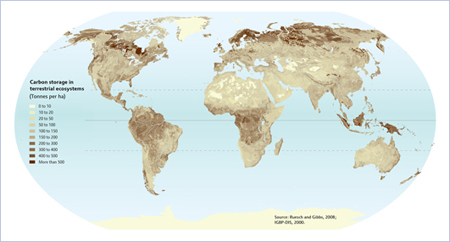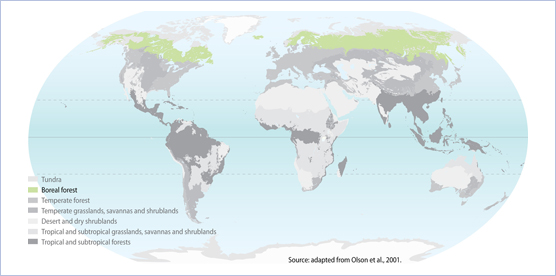I recently came across this report by the United Nations Environment Programme (UNEP) that discusses the importance of conserving natural ecosystems that store, and often capture, carbon.
As you probably know, the Boreal Forest stores a massive quantity of carbon, which is easily released by industrial development. There were two passages in the report that stood out to me, which help to illuminate just how important the Boreal Forest is as a carbon storehouse. The two maps really help as well if you are a visual learner. I particularly like the first map, as it shows how much carbon there really is in the Boreal Forest compared to other parts of the world.
I've pasted sections from the full report below. To see the report as a whole, visit:
http://www.grida.no/publications/rr/natural-fix/
___________________________________
CURRENT CARBON STOCKS IN BIOMASS AND SOIL
Terrestrial ecosystems store almost three times as much carbon as is in the atmosphere. Tropical and boreal forests represent the largest stores. The maintenance of existing carbon reservoirs is among the highest priorities in striving for climate change mitigation.
Terrestrial ecosystems store about 2100 Gt C in living organisms, litter and soil organic matter, which is almost three times that currently present in the atmosphere. Different ecosystem types store different amounts of carbon depending on their species compositions, soil types, climate and other features. This map shows today's best available map of the terrestrial distribution of carbon. It combines a globally consistent dataset of carbon stored in live biomass (Ruesch and Gibbs 2008) with a dataset on soil carbon to 1 m depth (IGBP-DIS 2000, this is likely to underestimate carbon stored in peat soils). It shows that the largest amounts of carbon are stored in the tropics, mostly as biomass, and in high latitude ecosystems where the stocks are largely located in permanently frozen layers of soil (permafrost) and in peat.

Credit: Riccardo Pravettoni, UNEP/GRID-Arendal
Dividing the world into seven biomes, we estimate that tropical and subtropical forests store the largest amount of carbon, almost 550 Gt. The boreal forest biome then follows with carbon stocks of approximately 384 Gt. While deserts and dry shrublands have very little aboveground biomass, they are significant soil carbon reservoirs and cover very large areas, so that their overall contribution to carbon storage is notable. Conversely, the tundra biome covers the smallest area, but has the highest density of carbon storage.
___________________________________
BOREAL FOREST
The boreal forest biome holds the second largest stock of carbon; most of this is stored in the soil and litter. The draining of boreal forest peatlands, inappropriate forestry practices and poor fire management may all cause significant losses of the carbon stored in this ecosystem.
Boreal forests occupy large areas of the northern hemisphere and are mainly found in Canada, Russia, Alaska and Scandinavia. Biodiversity in these forests is generally low. Plant biomass is much higher than in the tundra, with roughly 60-100 tonnes of carbon per hectare, of which around 80% is in the above-ground biomass (Mahli et al. 1999; Luyssaert et al. 2007). Because of the low temperatures, decomposition in boreal forests is slow. This leads, as in the tundra, to large accumulations of carbon in the soil pool (116-343 t C per ha, Mahli et al., 1999; Amundson 2001). Fire is common in boreal forests and is one of the main drivers of the carbon balance here, with carbon being lost from the system when fire frequencies are high (Bond-Lamberty et al. 2007). There is debate about whether the very mature old-growth boreal forests are currently a carbon source or a carbon sink, though recent studies suggest that these old-growth forests may indeed be carbon sinks (Luyssaert et al. 2008). In general, due to the low decomposition rates and the extensive peatlands they can grow on, boreal forests are considered to be important carbon sinks.

Credit: Riccardo Pravettoni, UNEP/GRID-Arendal
HUMAN IMPACTS AND IMPLICATIONS FOR CARBON MANAGEMENT
Increasing human pressure on these forests, through logging and mining, and the draining of the peatlands these forests grow on, releases carbon to the atmosphere and significantly reduces their carbon storage capacity. Protection of boreal forests against logging and implementing best forestry practices may therefore reduce carbon emissions, sustain carbon stocks, and maintain uptake by these forests.

